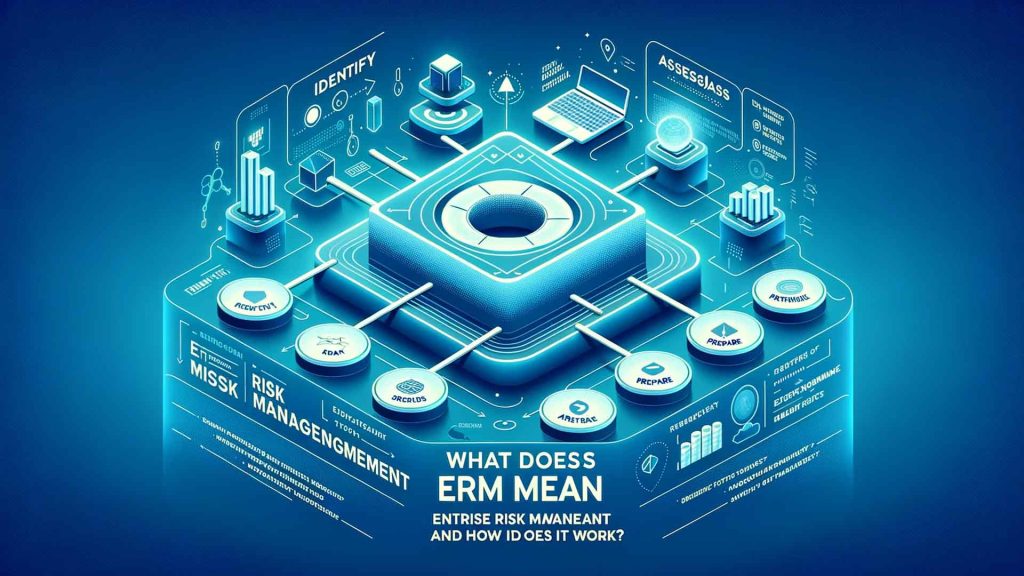Enterprise risk management (ERM) is a strategic methodology that examines risk management comprehensively, considering the entire organization. It employs a top-down approach with the goal of recognizing, evaluating, and preparing for possible losses, threats, hazards, and other sources of potential harm that could disrupt an organization’s operations and goals or result in financial losses.
What Is Enterprise Risk Management (ERM)?
KEY TAKEAWAYS
- Enterprise risk management (ERM) is a company-wide strategy aimed at identifying and preparing for potential hazards related to a company’s finances, operations, and objectives.
- ERM enables managers to influence the overall risk profile of the company by requiring specific business segments to either engage in or discontinue particular activities.
- Traditional risk management, which delegates decision-making authority to division heads, can result in isolated assessments that fail to consider the broader organizational context.
- The COSO framework for enterprise risk management outlines eight essential components for developing ERM practices.
- Successful ERM strategies can help mitigate various types of risks, including operational, financial, security, compliance, legal, and many others.

Comprehending Enterprise Risk Management (ERM)
Enterprise risk management adopts a comprehensive approach and requires decision-making at the management level that may not necessarily align with the interests of an individual business unit or segment. Therefore, instead of each business unit being solely responsible for its own risk management, a priority is placed on firm-wide oversight. ????????
It frequently entails sharing the risk action plan with all stakeholders as part of an annual report. Various industries, including aviation ✈️, construction ????️, public health ????, international development ????, energy ⚡, finance ????, and insurance ????, have all transitioned to adopting ERM. ????????
Enterprise Risk Management (ERM) can effectively reduce overall risk within a firm and also uncover distinctive firm-wide opportunities. Effective communication and coordination among various business units play a pivotal role in ensuring the success of ERM. This is especially important because decisions about risk made by top management may sometimes appear to be in conflict with the on-ground assessments made by local teams. Companies employing ERM generally establish a dedicated enterprise risk management team responsible for overseeing the firm’s operations. ????️????????
While best practices and standards in Enterprise Risk Management (ERM) are still evolving, they have been formalized through COSO, an industry group that maintains and updates such guidance for companies and ERM professionals. ????????
A Comprehensive Approach to Risk Management
Contemporary businesses encounter a wide range of risks and potential threats. Historically, companies typically managed their risk exposures by having each division handle its own affairs. Enterprise risk management requires corporations to identify all the risks they encounter. It also prompts management to determine which risks to actively address. Unlike risks being isolated within individual company divisions, ERM enables a company to gain a holistic perspective. ????????
Enterprise Risk Management (ERM) views each business unit as a ‘portfolio’ within the company and aims to comprehend the interactions and overlaps of risks affecting individual business units. Additionally, it can identify potential risk factors that may go unnoticed by individual units. ????????
A Chief Risk Officer (CRO), for example, is a corporate executive position mandated by an Enterprise Risk Management (ERM) perspective. The CRO holds the responsibility of identifying, analyzing, and mitigating both internal and external risks affecting the entire corporation. Additionally, the CRO ensures the company’s compliance with government regulations, including Sarbanes-Oxley (SOX), and evaluates factors that may jeopardize investments or a company’s business units. The CRO’s specific mandate is determined in collaboration with other senior management members, the board of directors, and other stakeholders. ????????????????
What Types of Risks Does Enterprise Risk Management Address?
Enterprise Risk Management (ERM) can help develop plans for almost any type of business risk that threatens a company’s ability to survive. These risks can be further classified into different categories discussed below. In general, ERM most commonly addresses the following types of risk:
Compliance Risk: This risk arises when a company violates external laws or requirements. An example of compliance risk is a company’s inability to produce timely financial statements in accordance with applicable accounting rules, such as GAAP (Generally Accepted Accounting Principles). ????⚖️
Legal Risk: Legal risk threatens a company when it faces lawsuits or penalties related to contractual disputes or regulatory issues. An example of legal risk is a billing dispute with a major customer. ⚖️????
Strategic Risk: This type of risk endangers a company’s long-term plans. For example, new market entrants in the future may replace the company as the lowest-cost provider of a particular product or service. ????????
Operational Risk: Operational risk pertains to threats to the day-to-day activities necessary for the company to function. An example of operational risk is a natural disaster damaging a company’s warehouse where inventory is stored. ????️????
Security Risk: Security risk jeopardizes the company’s assets if physical or digital assets are misappropriated. An example of security risk is inadequate controls overseeing sensitive client information stored on network servers. ????????
Financial Risk: Financial risk affects a company’s debt or financial stability. An example of financial risk is incurring losses due to fluctuations in foreign currency exchange rates. ????????
What Is ERM and Why Is It Important?
ERM is a company’s approach to managing risk. It encompasses the practices, policies, and framework that guide how a company handles various risks it faces. ERM is crucial because it helps prevent losses and unexpected negative outcomes. Additionally, ERM is essential for strategically addressing risk and gaining employee support. ????????????
What Are the 3 Types of Enterprise Risk?
ERM typically categorizes the risks a company faces into three main types: operational, financial, and strategic risks. Operational risks impact day-to-day operations, while strategic risks affect long-term plans. Financial risks impact the overall financial health of a company. ????????????
What Are the 8 Components of ERM?
The COSO framework for ERM identifies eight core components: internal environment, objective setting, event identification, risk assessment, risk response, control activities, information and communication, and monitoring. These components form the foundation of a company’s ERM practices. ????????????
What Is the Difference Between Risk Management and Enterprise Risk Management?
Traditionally, risk management referred to practices and policies related to specific risks a company encounters. In contrast, modern risk management introduces ERM, which is a comprehensive, company-wide approach to view risk holistically across the entire organization. ????????
The Bottom Line
As a company manufactures, sells, and delivers goods to customers, it faces numerous risks from various sources. To better prepare for these risks, companies are increasingly adopting enterprise risk management—a company-wide, top-down approach to assess and plan for risk. The ultimate goal of ERM is to safeguard a company’s assets and operations while having strategies in place to address unforeseen events. ????????????
Interjection: ‘erm.’ (UK) Used in hesitant speech or to express uncertainty; ‘um,’ ‘umm.’ She was going to, ‘erm’… the salon, I think. (UK) Used to express embarrassment or subtle disagreement.
Enterprise Risk Management (ERM) is the process of planning, organizing, directing, and controlling the activities of an organization to minimize the harmful effects of risk on its capital and earnings.






